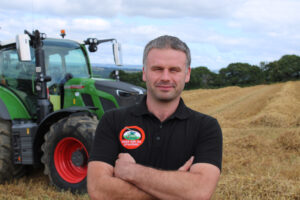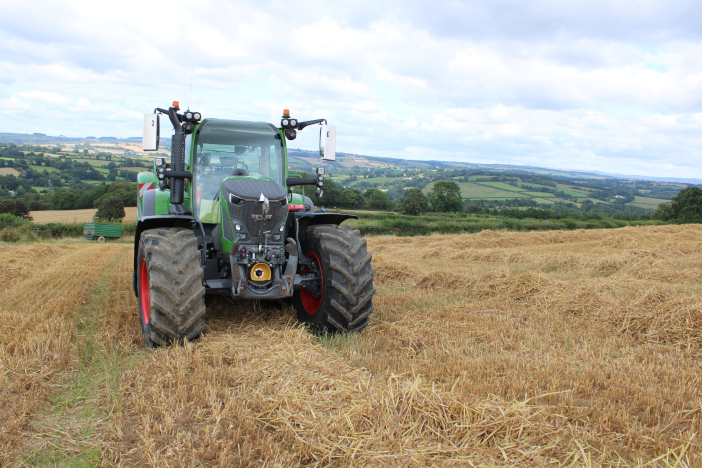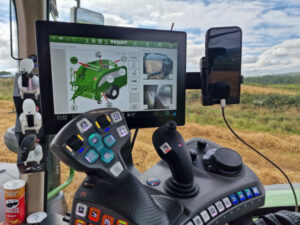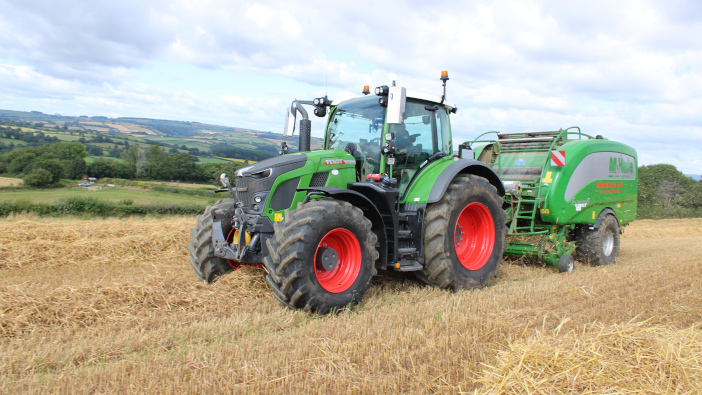Cornish contractor Tamar Agri was one of the first to take delivery of the new Fendt 620 Vario, supplied by dealer Alan Snow. With 1,200 hours under its belt, the new tractor has fitted in so well that the business has another on order.
Operating from Tamar Ridge Farm, near Callington, the contracting business operates eight Fendt tractors to manage around 4,050ha of grass and maize foraging, along with 810ha of cereal planting and harvesting.
“The 620 replaced a 724 Gen 6, and we were sceptical about whether a four-cylinder tractor could manage the same work as the six-cylinder, but it has performed brilliantly and is saving the business a significant amount of money on fuel,” says Tamar Agri’s Sam Bloye.
He has put the 620 Power Plus model to work muck spreading, square baling and hedge cutting since taking delivery at the start of 2025.
“We operate a six-string Krone 1290 square baler, and we were concerned the 620 wouldn’t have the grunt to operate with it, especially on our undulating land. However, it has performed well and, despite being significantly lighter than the 724, it hasn’t struggled to hold back the baler in sloping fields,” he says.
There are four models in the 600 Vario range, including a 614, 616, 618 and 620. Power outputs range from 149hp to 209hp and feature the Dynamic Performance system that can provide an additional 15hp regardless of forward speed.
The engine is a newly developed, four-cylinder, five-litre, Agco Power Core50 powerplant with a top road speed of up to 50kph at 1,250rpm and offers 950Nm from 1,200rpm to 1,600rpm.

“We have established that it has the power to rival the 724 and, while it is not quite as good for hauling on the road, it is every bit as good in the field,” he says.
With a power-to-weight ratio of 34.4kg/hp, the 600 Vario is also very manoeuvrable, providing a turning circle of just 10.2m with 540/65 R30 tyres.
“It is a nimble machine, and our operators have been very happy with the new cab, which is a step up from the 724 and has a more intuitive terminal with programmable presets for pretty much everything,” he adds.
Working the ground
To further test the 620, it has been ballasted with a 1,250kg front weight to operate a 6m Kuhn power harrow and a six furrow Kverneland plough.
“We are using the same ballast as we did with the 724, and the 620 is managing well with both the power harrow and the plough, but the real test will be in the autumn when the soils are heavier. The big difference is in fuel consumption, which has been an eye-opener,” he says.
He suggests the 620 has averaged 11 litres/hr on the power harrow. This, compared to 17 litres/hr with the 724, is a big margin. Similarly, the 620 has used 16 litres/hr on the road for haulage work, which the 724 needed 22 litres to achieve.
“These are big margins that will add up to a serious saving over the four years that we plan to have this tractor, and it is the main reason why we have ordered another,” he says.
Should the 620 go on to do 8,000 hours over four years, the potential saving could be as much as 48,000 litres of fuel, based on an average saving of 6 litres/hr.
“We want to offer our customers the best value, and this can only be achieved by using the latest technology to do the best job whilst keeping on top of our operating costs,” he says.

The business has always invested in larger machinery to optimise time. However, the 620 has bucked the trend by being a smaller, lighter tractor that can achieve what the larger 724 was, but with the added fuel-saving benefit.
“There is one drawback, but it is the only one we have come across. The fuel tank is smaller than the 724. The capacity of the 620 is 347 litres and the 724 is 400, so it makes a difference to fuelling, but really with the fuel saving of the 62,0 there isn’t much in it,” he says.
Fendt’s latest VarioDrive transmission, which was launched on the Fendt 1000 Vario, has moved down through the Fendt tractor range. The newly developed, single-stage transmission provides independent control of the front and rear axles and measures slip on all four wheels to adjust how much power is fed to each. It means the tractor moves from standstill to 50kph without the need for the operator to make any manual changes. It is also able to do this at just 1250rpm.
“Not having to change range makes the 620 much easier to live with, especially at lower speeds and at headlands. It is also easier to manage for operators who don’t use the tractor very often or are less experienced,” he says.
On-board technology
The 600 Vario series features the FendtONE operating concept. This was introduced on 700 Vario Gen6 tractors, so it is familiar to the Tamar Agri team. It gives them flexibility to tailor the controls and displays to suit different jobs. There is also a multifunction joystick, 10in digital dashboard and a 12in touchscreen terminal on the armrest.
“Our operators like the simplicity of FendtONE, and it makes sharing tractors much easier. The 620 cab is also a relaxed environment, which is important for long shifts,” he adds.
 Tractor settings and performance data, GPS field maps and Isobus-implement displays can be allocated to any of the screens, and there is also the option to show the same information on multiple screens or divide the screens into sections, each displaying different images or data.
Tractor settings and performance data, GPS field maps and Isobus-implement displays can be allocated to any of the screens, and there is also the option to show the same information on multiple screens or divide the screens into sections, each displaying different images or data.
“We are yet to make full use of FendtONE offboard, which will enable me to see where the tractors are, how much fuel they are using and how long it is taking them to complete tasks, but it won’t be long before this is up and running,” he says.
With the first 620 well bedded in, he has chosen to replace another of the 700s in the fleet with a 620 of the same specification. Dealer Alan Snow is supplying the second tractor and has been supportive in helping him manage the fleet.
“The support from Alan Snow is essential to our business. They have never left us without a tractor and provide an excellent backup service. Sourcing 620s is apparently tricky at the moment as they appear to be in high demand, so I am pleased our second one is on the way,” he says.
With 6,000 square bales, 12,000 round bales and the full cereal area to harvest, it is a busy time of year. However, cultivation looms and with it a new challenge for the 620.
“The next big test will be how it compares to the 724 when the ground gets tough and it’s pulling the plough or working the power harrow. We have tried it a couple of times, but the coming cultivation season will be its first operating for prolonged periods. That said, we have every confidence, and I can see the fleet including more 600 series tractors in the future,” he concludes.



